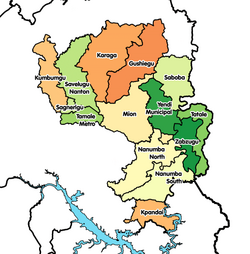Yendi Municipal District Naa Ya which means, The King's City | |
|---|---|
Municipal District | |
| Nickname: Sankara Yili | |
 Districts of Northern Region | |
Location of Yendi Municipal District within Northern | |
| Coordinates: 9°26′26.88″N0°0′21.24″W / 9.4408000°N 0.0059000°W | |
| Country | |
| Region | Northern |
| Capital | Yendi |
| Government | |
| • Municipal Chief Executive | Issah Zakaria |
| Population (2021 census) | |
• Total | 154,421 [1] |
| Time zone | UTC+0 (GMT) |
| ISO 3166 code | GH-NP-YE |
Yendi Municipal District is one of the sixteen districts in Northern Region, Ghana. Originally created as an ordinary district assembly in 1988 when it was known as Yendi District , which was created from the former East Dagomba District Council, until it was elevated to municipal district assembly status on 29 February 2008 to become Yendi Municipal District. However, on 28 June 2012, the western part of the district was later split to create Mion District with the remaining part retained as Yendi Municipal District. The municipality is located in the central part of Northern Region and has Yendi as its capital town.

